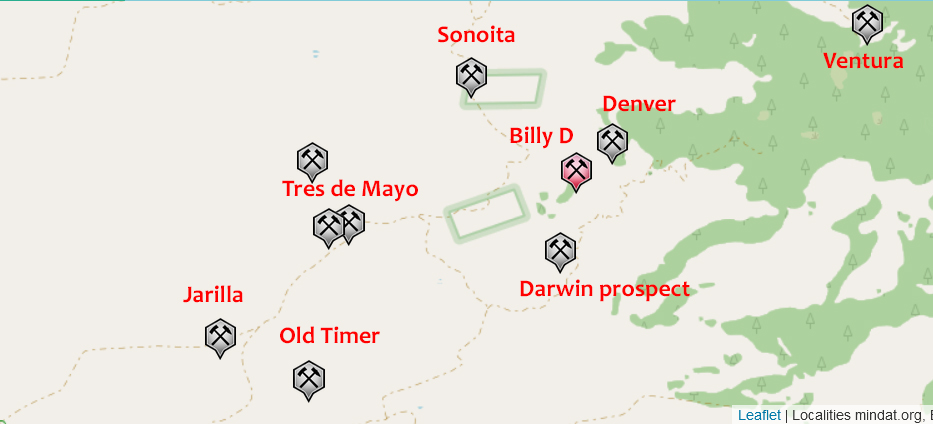
|
|
|
Mines Menu:
Mines Map
Use the links at the left to return.
|
|
Mine Descriptions |
|
Tres de Mayo Mine | |
Alternate NamesPalmetto CompanyRobert E. (bob) Lee, Hassayampa, Hollywood, La Palma, Stockton, Backman & Merritt Mies Co, Monarch Mining & Milling Co., Taft Mining & Exploration Co., Melville Syndicate, Newcomer, Cummings5. Mining District and MinesPalmetto District
Arizona Geological Survey Mining datahttp://docs.azgs.az.gov/OnlineAccessMineFiles/S-Z/TresdemayomineSantacruz106b.pdf LocationWest side of Patagonia Mountains 23S 14E NW¼ 285 31.4032N, 110.92596W4 Mineral ProductsAg, Pb, Au-, Cu-, Zn-, Mn-.5 Shaft, tunnel, adit, pit and open cut operations. Worked sporadically from prior to 1900 to 1941 producing some 100 tons of ore averaging about 5% Pb, 5 oz. Ag/T, 0.5 oz. Au/T, and up to 0.55 Cu.5 GeologyThe country rock is quartz monzonite intruded by small disconnected masses of diorite in the form of sheets and dykes. The quartz monzonite and the diorite near the contacts are both chloritized and epidotized, the diorite having apparently suffered the greatest alteration. The deposits occur mainly in two veins situated about 300 feet apart and contained in the quartz monzonite in association with the intrusive diorite. The vein filing is white quartz, limonite, and psilomelane, all much sheared and broken, forming a brecciated mass of yellowish-brown to black color. A considerable part of the filling as locally shown on the surface is sheared, broken and altered quartz monzonite. The black mineral consists of manganese with a little lead and seemingly some argenite. The southwest vein, on which the shafts are sunk, dips 85° SW. It is 2 feet wide between walls of sheared quartz monzonite seperated from the ledge matter by gouge. The principal ore material is argentiferous galena, but the mine has also produced considerable ore rich in horn silver2. Lenses of argemtiferous galena with minor chalcopyrite and sphalerite in a quartz, psilomelane, and gouge gangue in fissure-zone veins, oxidized to cerussite, argentite, an rich cerargyrite pockets. Wall rock is strongly sheared and fractured Precambian rock intruced by Jurassic granite. A major fault passes through the area and a northeast striking fracture zone contains weak, oxidzed suphide mineralization. Psilomelane often contains lead and silver values.5 Type of Operation and ProductionThe Palmetto mine is a little south of the center of the district and a mile north of the Jarilla mine, on open ground at an elevation of about 4,300 feet. It was located by A. J. Stockton and partners, of Patagonia in 1880, when there were at thos place some old shafts that were probably sunk by Mexicans in the early days. It is opened by three shafts sunk on the vein. All the shafts contain water, and in the south shaft, located in a gulch, water stands within 6 feet of the collar. Several pits show surface ores2. Shaft operations. Worked by Mexicans prior to 1880 but mainly from 1910 through 1942, producing in total some 200 tons of ore averaging 70 oz. of Ag/T, 25% Pb, and minor Cu and Au 5. References
|
